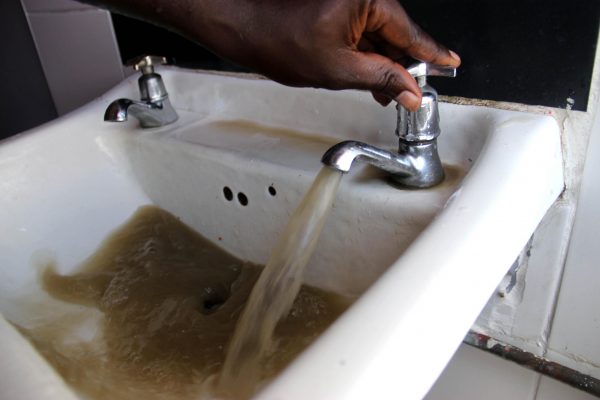
Harare’s piped water is dirty and smells foul when it is available, but scientific research indicates that it could also be killing residents slowly and silently.
BY XOLISANI NCUBE
Health minister David Parirenyatwa — during The Standard’s three-month investigation into why Harare water is dirty and the possible effects of its poor quality on consumers’ health done in collaboration with the Information for Development Trust (IDT) — acknowledged that the capital’s running water is failing to meet World Health Organisation (WHO) standards.
“According to WHO standards, water for consumption should be odourless and colourless but when you look at Harare water, it falls short of that,” Parirenyatwa said. “The smell on its own makes it imperfect for human consumption, hence my appeal would be that people should boil the water even though council says they treat it.” Harare mayor Bernard Manyenyeni said pretty the same thing last December when he was petitioned by angry residents who brought with them samples of the dirty water to Town House.
He admitted that the local authority was pumping out partially treated water because it had run out of money to buy the requisite purifying chemicals.
All suburbs and industrial sites in the capital go without running water for long periods and, when they get the precious liquid, it is brownish, leaves an unsightly froth when settled in a container, sometimes turns greenish, has dregs that some residents have said look like raw sewage particles and smells foul.
After a few days, water from the tap looks clean to the naked eye, but if left in a container for some time it leaves stubborn stains in the holders.
Predictably, the poor are particularly affected, as investigations revealed. The percentage of people directly consuming tap water is high in south-western and south-eastern suburbs where household incomes are generally low even though literacy is fairly high.
- Chamisa under fire over US$120K donation
- Mavhunga puts DeMbare into Chibuku quarterfinals
- Pension funds bet on Cabora Bassa oilfields
- Councils defy govt fire tender directive
Keep Reading
These include areas like Mbare, Glen Norah, Glen view, Highfield, Warren Park, Dzivarasekwa, Chitungwiza, Mabvuku and Tafara.
The residents use tap water for drinking, cooking, bathing and washing and a significant number also admitted to using raw tap water for religious purposes that involve direct ingestion, particularly on the prescription of Apostolic sect and traditional healers.
While some of the residents in these suburbs were found to heed the call to boil or chlorinate the tap water, they still represented a small figure among the people interviewed.
Even in relatively more affluent suburbs like Eastlea and Queensdale, substantial numbers of residents, among them university graduates, still drink straight from the tap and their reason was blunt: “We are used to it and we don’t seem to be suffering any side effects after all.”
Many indicated that borehole water was a better option, but were quick to point out that the boreholes were breaking down while the working ones produced rusty water with a heavy oily smell. Buying mineral water was an option for a few who could spare the money.
The greenish pigment in the water, according to a University of Zimbabwe lecturer and water purification expert, Zvikomborero Hoko, is an indication of the presence of algae.
“Harare needs to upgrade the processes at its water treatment plants so that it can effectively deal with the poor quality of raw water and emerging pollutants such as algae, pesticides and other discharges (including from industries) that are allowed into the lake without treatment,” he said.
“Algae that passes through the treatment system has potential for re-growth in the water distribution system and the chances for this increase when there is low chlorine in the water distribution system.
“This gives the greenish pigment in water, especially when stored for long periods and particularly when exposed to sunlight and heat.”
The failure to rid the water reticulation system at Morton Jaffray waterworks that draws the raw water from Lake Chivero of algae is partly due to the unreliable purification system that Harare City Council is using and must be rehabilitated, noted Hoko.
“The conventional water treatment system used at the Morton Jaffray waterworks is unable to deal with the highly polluted raw water and emerging pollutants such as pesticides and algae, among others,” Hoko said.
“As such, the treatment system has no capacity to completely remove certain species of algae and other emerging pollutants.”
Even if Morton Jaffray could completely remove all contaminants, cracked pipes with worn-out joints create high chances of re-contamination down the distribution line, especially where water supply is intermittent and the groundwater table is above the pipes.
There are chances of sewage seeping into the treated water too.
“In areas where water pipes are running parallel and near sewer lines as is the case in most high-density suburbs and when the sewer line blocks or chokes, and a water pipe bursts or has a leak or crack or worn-out joints, there is a potential disaster,” Hoko said.
According to the United States Environmental Protection Agency (EPA), algae are sometimes considered plants because they photosynthesise, although some of them are mobile and would require high tech equipment to detect and remove — Harare does not have such equipment at the moment.
Lake Chivero, the Environmental Management Agency (EMA) has already admitted, is heavily polluted with raw sewage flowing into it, in addition to effluent discharge from industry and streambank cultivation.
EMA spokesperson Steady Kangata told The Standard that the situation at the lake was deplorable and that this was due to activities in urban settlements.
But if results from EMA are anything to go by, council is the biggest culprit as it discharges untreated sewage into Lake Chivero and has failed to deal with solid waste, in the process contaminating its own raw water sources.
This investigation learnt through independent sources in the water department that Morton Jaffray also lacks advanced technologies to detect contamination at the reticulation stage and along the distribution chain.
The plant was built in 1953 for a population of several thousands of consumers, against the currently estimated three million and was built on the assumption that water from the lake would be negligibly polluted.
Records at hand suggest that, for decades from its construction, at least three purification chemicals were used. Today, council is supposed to use up to seven chemicals due to the high level of pollution of its raw water.
Indications from council records suggest that the plant was last upgraded in 1994 — and until then, the level of contamination such as new types and forms of algae had not significantly evolved.
“The state of the plant needs to improve; it is no longer compatible for the state of raw water.
“For example, sand filters are no longer perfect, so a certain grade of sand can pass through and this is the reason why you find water, which has residual impurities,” said a council staffer.
Besides pipe corrosion, Harare water’s colour has also been affected by the shortage of HTH chlorine — a chemical used to kill the algae (green colour), internal memos suggested.
The municipality requires 1 440kg of HTH per day to purify 500 mega litres of water, but it is dismally failing to procure the chemical.
Treated water should have residual chlorine to deal with any re-contamination in the furthest parts of the distribution system, but current shortages are undermining that.
Council has also been facing short supply of aluminium sulphate, a cleaning additive, which is locally available from a government-owned supplier, but the local authority has opted to buy it from a private firm, Rockcastle, at an inflated price, The Standard established.
Council officials could not explain this extravagance, and Rockcastle, a foreign-linked company, would not respond to questions sent to it via email and its key staff did not pick up calls despite repeated attempts.
The presence of residual slime in the tap water is due to the shortage of sodium silicate, a chemical that aids in making contaminants settle during water treatment. The shortage of the product has seen solids being carried over into the distribution system and consequently settling at the base whenever water is placed in a container for a while.
Despite all these problems, council’s director of water Hosea Chisango said they tested the water at three stages to ensure it met stipulated health standards. “Our water is tested from the intake to inform the treatment process. It is tested throughout the treatment process,” he said.
“We also have some testing points within the distribution system, including some customer taps.”
But he admitted that the process was not perfect and more measures were needed to avoid disaster.
The biggest health scare relating to Harare’s dirty water is the confirmed presence of algae.
Scientists have noted that algae in drinking water may pose no health hazard if it exists in small quantities, but where there is no capacity to arrest its growth and presence, this can degenerate into a serious health hazard.
According to the US EPA, drinking water with algae exposes people to health complications like rashes, stomach or liver illness, respiratory problems as well as neurological effects.
EPA suggests that generally, the treated water would have harmful compounds or by-products coming from the mixture of water treatment chemicals and pollutants, which include toxins from algae.
“These by-products have been linked to reproductive and developmental health risks and even cancer,” reads part of the EPA findings.
On its website, EPA notes that algae “produce extremely dangerous toxins that can sicken or kill people and animals”.
Damage to humans and animals can occur through external exposure to and ingestion of algae-produced toxins.
A 2003 WHO background paper on drinking water quality indicated that using algae-infested water for recreational purposes like swimming was inked to human illnesses in numerous countries.
The health complications included diarrhoea, muscle pains, joint aches as well as irritation of the skin, eyes and throat.
The paper covered such countries like South Africa, the US, Australia and China.
For China, it noted that liver cancer was linked to the consumption of water with algae-produced toxins.
If sewage can seep into drinking water, this could hugely contribute to the outbreak of water-borne diseases such as cholera and typhoid.
The origins of the 2008 cholera outbreak that killed more than 4 000 people in a short space of time have not yet been established, but if the killer strain was spread through human waste, it is possible it could have found its way into running water.
Harare records thousands of typhoid cases every year, according to available Health ministry records, but, fortunately, only a few have been fatal in the post-2008 era.
Parirenyatwa opined that council’s failure to deal with old pipes that were susceptible to rust and corrosiveness had exposed residents to various health risks.
“Corrosive water may dissolve enough metals to create water that is unsafe for consumption,” he said.
“It depends with the materials used on the pipes, but metals such as copper may cause aesthetic and health-related problems.”
The minister stated that corrosive water can also cause pain problems and other health-related challenges.
“Corrosion of copper pipes can leave obvious bluish-green stains around sinks and bathroom fixtures and it may give the water a metallic taste,” Parirenyatwa added.











